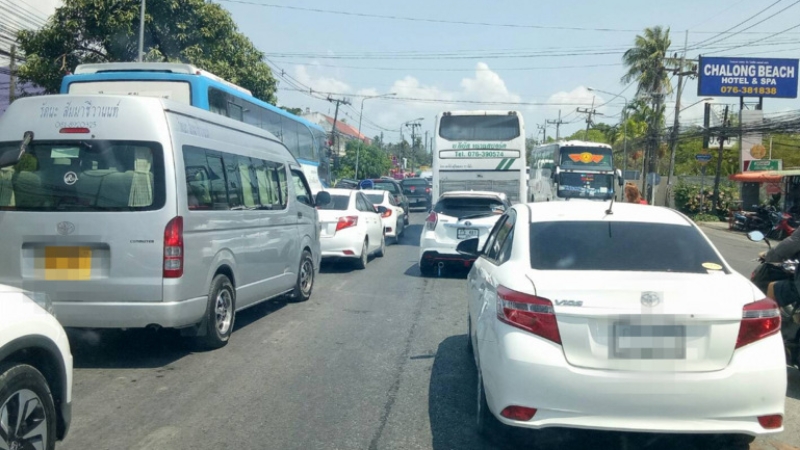So far, the government’s solution has been to build more underpasses and to expand the number of lanes. This may create some short-term relief, but in the long-term this will not work because of a well-known phenomenon known as Jevons Paradox. Applied to roads, the paradox notes that the more roads we add, the more it will encourage people to drive, which leads to a never-ending game of road expansion.
So, what can we do to solve Phuket’s worsening traffic problem? We need a multi-faceted approach that increases the flow of traffic, while getting people to ditch their cars in favour of alternative transportation or just walking and biking.
Roundabouts
What if we could solve Phuket’s traffic problem, while saving money, reducing traffic accidents, saving lives, reducing air pollution, fighting climate change, increasing biodiversity, improving road aesthetics and improving the quality of life on the island?
Sound like a tall order? Studies show that roundabouts can increase traffic flow by as much as 50% over traffic lights and stop signs. This is because cars are constantly moving rather than sitting and idling, which also reduces fuel consumption and cuts air pollution.
This reduces the number of lanes needed, while reducing car crashes that result in serious injuries or death, since cars are moving at a slower speed, and they are approaching each other at a different angle, which means roundabouts eliminate head-on collisions. According to the United States Federal Highway Administration, roundabouts decreased crashes involving serious injuries by 82% compared to stop signs and by 78% compared with traffic lights.
They are also considerably cheaper than traffic lights, which can cost up to US$400,000 to install in the United States and cost $5,000-8,000 per year in electricity costs plus maintenance costs. Roundabouts cost between $250,000-500,000 depending on the complexity. Although not inexpensive, once built, there is little in the way of maintenance costs and they can be aesthetically pleasing, with art, manicured gardens, hedges and trees, which can help to fight air pollution, increase biodiversity and decrease flooding. Roundabouts are also considerably sturdier than traffic lights and not affected by the frequent storms and power outages we get on Phuket.
Although the island already has a handful of roundabouts, given its size and population density, it has nowhere near enough. For example, Carmel Indiana has a population of 100,000 and has almost 150 roundabouts. It is also, not coincidentally, been voted one of the best places to live in America because it is a safe, green place to live, with lots of walking and bike paths instead of traffic.
Bike Lanes and Walking Paths
Getting people out of their cars should be the goal, so adding more bike lanes and walking paths to Phuket infrastructure would accomplish this. In urban areas 50% of trips are 10km or less, a perfect distance for walking and biking. A 2021 study showed that in cities where governments installed bike paths, the number of cyclists increased by between 11-48%.
Some roads in Phuket are too narrow for both cars and bikes, but there are plenty that are ideal for bike lanes. For example, the area around Laguna could have a network of bike lanes connecting the gated estates to Boat Avenue, which could also double as race courses during triathlons and marathons. This would go a long way to easing the constant congestion that plagues the area.
Street Cars Desired
The next step would be to improve public transport. There has been a lot of debate about putting in a $1 billion light rail system versus adding an electric bus system, but both solutions have problems. A light rail system is expensive to install, operate and maintain, and given the seasonal economics of Phuket and the transient nature of its population, would likely never break-even much less turn a profit.
The problem with buses is that they only provide a single point of entry, making it slow to get on them, and once riders are on, they are in for a jerky ride. They also billow clouds of smoke and since they don’t always run on time, it makes depending on them difficult, so people who drive cars stay in them.
Studies show that while buses are useful for lower-income people who don’t have cars, they are not terribly effective at getting people that have cars out of them. However, there is another solution that isn’t being talked about.
Introducing trackless trams, also known as street cars. These are multi-car trams that run on wheels, not rails. So, they have the flexibility of a bus, with the conveniences of a tram. This means multiple points of entry making boarding and exiting quick and easy and a smoother steadier ride, which means people don’t mind standing as much.
Trackless trams are also electric, so they are quiet and don’t leave plumes of smoke behind. They are also considerably cheaper than a light rail system, coming in at just $6-8 million per kilometre and can be installed over a weekend, which means no construction delays.
As dozens of new developments around the island near completion, traffic is only going to get worse. By increasing traffic flow and reducing the number of cars on the road, we could improve the quality of life on Phuket immeasurably, while also saving lives and reducing pollution.
Palmer Owyoung is the author of ‘Solving the Climate Crisis: A Community Guide to Solving the Biggest Problem On the Planet.’ You can download the first three chapters from his blog PalmerOwyoung.me








